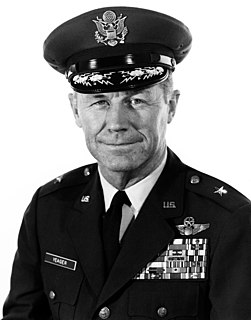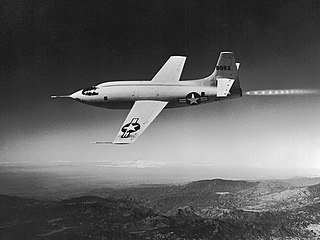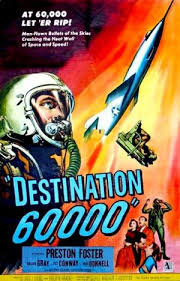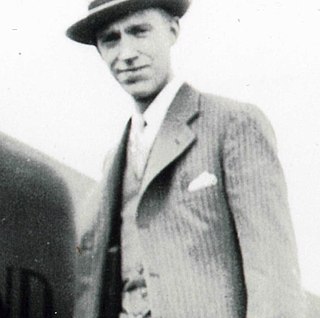Related Research Articles

Charles Elwood Yeager is a retired United States Air Force officer, flying ace, and record-setting test pilot. In 1947, he became the first pilot in history confirmed to have exceeded the speed of sound in level flight.

Edwards Air Force Base (AFB) is a United States Air Force installation located in Kern County in Edwards, California, about 22 miles (35 km) northeast of Lancaster, 15 miles (24 km) east of Rosamond and 5.5 miles (8.9 km) south of California City.

The Right Stuff is a 1983 American epic historical drama film written and directed by Philip Kaufman. It was adapted from Tom Wolfe's best-selling 1979 book of the same name about the Navy, Marine, and Air Force test pilots who were involved in aeronautical research at Edwards Air Force Base, California, as well as the Mercury Seven, the seven military pilots who were selected to be the astronauts for Project Mercury, the first human spaceflight by the United States. The film was written and directed by Philip Kaufman and stars Ed Harris, Scott Glenn, Sam Shepard, Fred Ward, Dennis Quaid and Barbara Hershey. Levon Helm narrates, and plays Air Force test pilot Jack Ridley.

The sound barrier or sonic barrier is the sudden increase in aerodynamic drag and other undesirable effects experienced by an aircraft or other object when it approaches the speed of sound. When aircraft first approached the speed of sound, these effects were seen as constituting a barrier making faster speeds very difficult or impossible. The term sound barrier is still sometimes used today to refer to aircraft reaching supersonic flight. Breaking this sound barrier produces a sonic boom.

The Bell X-1 is a rocket engine–powered aircraft, designated originally as the XS-1, and was a joint National Advisory Committee for Aeronautics–U.S. Army Air Forces–U.S. Air Force supersonic research project built by Bell Aircraft. Conceived during 1944 and designed and built in 1945, it achieved a speed of nearly 1,000 miles per hour in 1948. A derivative of this same design, the Bell X-1A, having greater fuel capacity and hence longer rocket burning time, exceeded 1,600 miles per hour in 1954. The X-1, piloted by Chuck Yeager, was the first manned airplane to exceed the speed of sound in level flight and was the first of the X-planes, a series of American experimental rocket planes designed for testing new technologies.

The Rutan Model 76 Voyager was the first aircraft to fly around the world without stopping or refueling. It was piloted by Dick Rutan and Jeana Yeager. The flight took off from Edwards Air Force Base's 15,000 foot runway in the Mojave Desert on December 14, 1986, and ended 9 days, 3 minutes and 44 seconds later on December 23, setting a flight endurance record. The aircraft flew westerly 26,366 statute miles at an average altitude of 11,000 feet (3,350 m).

The NASA Neil A. Armstrong Flight Research Center (AFRC) is an aeronautical research center operated by NASA. Its primary campus is located inside Edwards Air Force Base in California and is considered NASA's premier site for aeronautical research. AFRC operates some of the most advanced aircraft in the world and is known for many aviation firsts, including critical support for the first crewed airplane to exceed the speed of sound in level flight with the Bell X-1, highest speed ever recorded by a crewed, powered aircraft, the first pure digital fly-by-wire aircraft, and many others. AFRC also operates a second site in Palmdale, Ca. known as Building 703, once the former Rockwell International/North American Aviation production facility, next to Air Force Plant 42. There, AFRC houses and operates several of NASA's Science Mission Directorate aircraft including SOFIA, a DC-8 Flying Laboratory, a Gulfstream C-20A UAVSAR and ER-2 High Altitude Platform. David McBride is currently the center's director.

The Bell X-2 was an X-plane research aircraft built to investigate flight characteristics in the Mach 2–3 range. The X-2 was a rocket-powered, swept-wing research aircraft developed jointly in 1945 by Bell Aircraft Corporation, the United States Air Force and the National Advisory Committee for Aeronautics (NACA) to explore aerodynamic problems of supersonic flight and to expand the speed and altitude regimes obtained with the earlier X-1 series of research aircraft.

The Douglas D-558-2 Skyrocket is a rocket and jet-powered research supersonic aircraft built by the Douglas Aircraft Company for the United States Navy. On 20 November 1953, shortly before the 50th anniversary of powered flight, Scott Crossfield piloted the Skyrocket to Mach 2, or more than 1,290 mph (2076 km/h), the first time an aircraft had exceeded twice the speed of sound.

Joseph Albert Walker was an American World War II pilot, experimental physicist, NASA test pilot, and astronaut. He was one of twelve pilots who flew the North American X-15, an experimental spaceplane jointly operated by the Air Force and NASA.

Albert Scott Crossfield was an American naval officer and test pilot. In 1953, he became the first pilot to fly at twice the speed of sound. He was the first of twelve pilots who flew the North American X-15, an experimental spaceplane jointly operated by the United States Air Force and NASA.

The Boeing B-29 Superfortress was an aircraft produced in many experimental and production models.

The Douglas Skystreak was an American single-engine jet research aircraft of the 1940s. It was designed in 1945 by the Douglas Aircraft Company for the U.S. Navy Bureau of Aeronautics, in conjunction with the National Advisory Committee for Aeronautics (NACA). The Skystreaks were turbojet-powered aircraft that took off from the ground under their own power and had unswept flying surfaces.

Clarence Emil "Bud" Anderson is a retired officer in the United States Air Force, a triple ace of World War II, and the highest scoring living American fighter ace. During the war he was the highest scoring flying ace in his P-51 Mustang squadron. Towards the end of Anderson's two combat tours in Europe in 1944 he was promoted to major at 22, a young age even for a highly effective officer in wartime. After the war Anderson became a well regarded fighter test pilot, and a fighter squadron and wing commander. He served his wing commander tour in combat in the Vietnam War. He retired as a full colonel in 1972, after which he worked in flight test management for McDonnell Douglas. A member of the National Aviation Hall of Fame, Anderson has remained a sought after speaker at aviation and military events well into his 90s.

Toward the Unknown, originally called Flight Test Center and titled Brink of Hell in its UK release, is a 1956 film about the dawn of supersonic flight filmed on location at Edwards Air Force Base. Starring William Holden, Lloyd Nolan and Virginia Leith, the film features the screen debut of James Garner.

Albert G Boyd was a pioneering test pilot for the United States Air Force (USAF). During his 30-year career, he logged more than 23,000 hours of flight time in 723 military aircraft. When he retired in 1957, he had flown every aircraft type operated by the USAF, including attack, cargo, trainer, fighter, experimental, bomber, mission trainer, liaison, observation, and general aviation planes and helicopters.
William Barton Bridgeman was an American test pilot who broke aviation records while working for the Douglas Aircraft Company, testing experimental aircraft. In July 1951, the United States Navy announced the D-558-II Skyrocket piloted by Bridgeman had "attained the highest speed and altitude ever recorded by a piloted plane." On August 15 of the same year, he set a world record with a speed of Mach 1.88 and an unofficial record height of 79,494 feet (24,230 m).

Destination 60,000 is a 65-minute 1957 drama film, directed by George Waggner and produced by the Allied Artists Pictures. The film stars Preston Foster, Pat Conway and Jeff Donnell. Destination 60,000 depicts the life of test pilots flying the fastest experimental supersonic fighter designs from Edwards Air Force Base.

Carl Anson Cover was the chief test pilot and first to fly the Douglas Aircraft Company DC-1, DC-2, DC-3, DC-4, and the DC-5 airliners. Cover became Senior Vice President and General Manager for Douglas Aircraft and later Vice President of Bell Aircraft.
References
- Yeager, Chuck and Leo Janos. Yeager: An Autobiography. New York: Bantam, 1985. ISBN 978-0-553-25674-1.